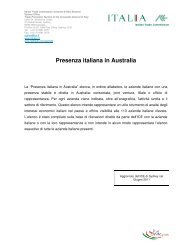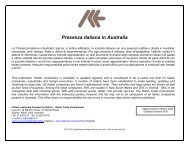Price Determination in the Australian Food Industry A Report
Price Determination in the Australian Food Industry A Report
Price Determination in the Australian Food Industry A Report
You also want an ePaper? Increase the reach of your titles
YUMPU automatically turns print PDFs into web optimized ePapers that Google loves.
Figure 35. Rump steak, grassfed, 1kg, supply cha<strong>in</strong> map<br />
Farmer<br />
Primary<br />
Process<br />
Secondary<br />
Process<br />
Market Logistics<br />
Retail<br />
saleyards/direct consignment<br />
transporter<br />
Brand Ownership/<br />
Management<br />
Fatten<strong>in</strong>g<br />
Property<br />
Broker/agent<br />
<strong>Food</strong> Service<br />
saleyards/private sale<br />
Abattoir and Bone Out<br />
Wholesalers<br />
Butcher<br />
Domestic<br />
Consumer<br />
Breed<strong>in</strong>g<br />
Property<br />
• 76,557 beef enterprises<br />
<strong>in</strong> Australia.<br />
• Around 25 million head<br />
of cattle.<br />
• Gross value of<br />
production around<br />
$5.7 billion, with 65% of<br />
production exported.<br />
• Feedlot sector has about<br />
27% of total production.<br />
• Ma<strong>in</strong> drivers of price –<br />
herd levels <strong>in</strong> competitive<br />
world market suppliercountries,<br />
export status<br />
of competitors, export<br />
market sector demand,<br />
consumer preferences,<br />
drought, health status.<br />
• Niche market supplier<br />
prices driven by <strong>the</strong>se<br />
are additional factors<br />
associated with quality.<br />
toll process route<br />
• There are around 250–300<br />
meat processors (beef and<br />
sheep meat) <strong>in</strong> Australia.<br />
• Around 25 large processors<br />
located across Australia<br />
process 61% of production.<br />
• Bone out is done primarily<br />
at <strong>the</strong> abattoir where <strong>the</strong><br />
animal was killed.<br />
• Increas<strong>in</strong>gly, producers are<br />
reta<strong>in</strong><strong>in</strong>g ownership of <strong>the</strong>ir<br />
beef beyond <strong>the</strong> farmgate<br />
and market<strong>in</strong>g it under <strong>the</strong>ir<br />
own brands. Therefore <strong>the</strong>y<br />
use <strong>the</strong> toll processors. This<br />
method is be<strong>in</strong>g<br />
undertaken by larger<br />
players.<br />
• Increas<strong>in</strong>g <strong>in</strong>tegration up<br />
and down <strong>the</strong> value cha<strong>in</strong><br />
is reduc<strong>in</strong>g <strong>the</strong> role and<br />
<strong>in</strong>fluence of a separate<br />
wholesale function.<br />
Cha<strong>in</strong> Retailer<br />
• Fresh beef is sold through<br />
major supermarket cha<strong>in</strong>s<br />
and butcher shops.<br />
BEEF – ANALYSIS OF PRICING<br />
Retail, wholesale and farmgate<br />
As discussed above, <strong>the</strong>re are dangers <strong>in</strong> simple comparisons between farmgate and retail prices.<br />
The limited long-term series price data for meat shows that <strong>the</strong>re is little correlation between<br />
levels of prices over time.<br />
Figure 36. Farmgate, retail and wholesale price trends, cents/kg, 1998–2003<br />
cents/kg<br />
1800.00<br />
1600.00<br />
1400.00<br />
1200.00<br />
1000.00<br />
800.00<br />
600.00<br />
400.00<br />
200.00<br />
0.00<br />
Source: MLA and NLRS<br />
retail silverside<br />
wholesale rump portions<br />
wholesale carcass<br />
yearl<strong>in</strong>g heifer sales OTH<br />
retail rump steak<br />
retail chuck<br />
Oct 1998 monthly June 2003<br />
<strong>Price</strong> <strong>Determ<strong>in</strong>ation</strong> <strong>in</strong> <strong>the</strong> <strong>Australian</strong> <strong>Food</strong> <strong>Industry</strong> A <strong>Report</strong><br />
41







